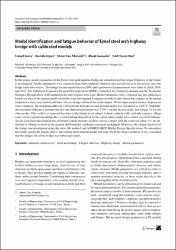| dc.contributor.author | Sunca, Fezayil | |
| dc.contributor.author | Ergün, Mustafa | |
| dc.contributor.author | Altunişik, Ahmet Can | |
| dc.contributor.author | Günaydın, Murat | |
| dc.contributor.author | Okur, Fatih Yesevi | |
| dc.date.accessioned | 2022-05-11T13:09:07Z | |
| dc.date.available | 2022-05-11T13:09:07Z | |
| dc.date.issued | 2021 | tr |
| dc.identifier.citation | Received: 18 February 2021 / Revised: 22 July 2021 / Accepted: 1 August 2021 / Published online: 12 August 2021
© Springer-Verlag GmbH Germany, part of Springer Nature 2021 | tr |
| dc.identifier.uri | https://hdl.handle.net/20.500.12418/12824 | |
| dc.description.abstract | In this paper, modal parameters of the Eynel steel arch highway bridge are identified and the fatigue behavior of the bridge is investigated. Modal parameters were extracted from three ambient vibration tests carried out over the period since the bridge came into service. The bridge became operational in 2009, and experimental measurements were taken in 2010, 2019, and 2021. The Enhanced Frequency Domain Decomposition (EFDD) method in the frequency domain and the Stochastic Subspace Identification (SSI) method in the time domain were used. Modal parameters were compared and any differences found over time in the measurement test results were investigated. Comparison of the results shows that changes in the natural frequencies were very limited and there was no change between the mode shapes. When experimental natural frequencies were compared, the maximum difference between the first and second measurements was calculated as 2.827%. Similarly, the maximum difference between the first and third measurements was 5.587% for the second mode, and around 3% for the other modes. This result is as expected because: (i) the bridge is not subject to heavy vehicle traffic and only connects village roads; (ii) no significant earthquake occurred during this period in the region which might have caused structural damage;
(iii) no corrosion was found in the structural system elements as there was no contact with the reservoir water; (iv) no settlement or sliding occurred in the ground and boundary conditions remained unchanged. Moreover, the fatigue behavior of the bridge was investigated using the stress life method and AASHTO LRFD Bridge Design Specifications. To rationalize the results against the fatigue effects, the verified finite element model was used. From the fatigue analyses, it was concluded that the fatigue life of the bridge was within safe limits. | tr |
| dc.language.iso | eng | tr |
| dc.relation.isversionof | 10.1007/s13349-021-00512-w | tr |
| dc.rights | info:eu-repo/semantics/closedAccess | tr |
| dc.subject | Ambient vibration test | tr |
| dc.subject | Steel arch bridge | tr |
| dc.subject | Fatigue behavior | tr |
| dc.subject | Highway bridge | tr |
| dc.subject | Modal parameters | tr |
| dc.title | Modal identification and fatigue behavior of Eynel steel arch highway bridge with calibrated models | tr |
| dc.type | article | tr |
| dc.relation.journal | Journal of Civil Structural Health Monitoring | tr |
| dc.contributor.department | Mühendislik Fakültesi | tr |
| dc.contributor.authorID | 0000-0003-3033-6237 | tr |
| dc.identifier.volume | 11 | tr |
| dc.identifier.endpage | 1354 | tr |
| dc.identifier.startpage | 1337 | tr |
| dc.relation.publicationcategory | Uluslararası Hakemli Dergide Makale - Kurum Öğretim Elemanı | tr |















